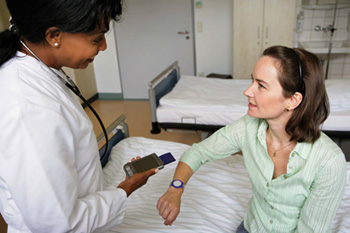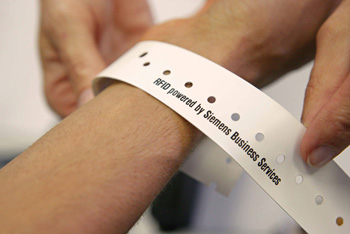
Against the background of medication errors and wrong treatments costing the health system several million dollars every year, RFID can provide an important contribution to improving the quality of treatment and increasing the safety of hospital routine.
In the Internal Medicine departments of German hospitals, 29,000 patients die each year as a result of being given the wrong medication, according to a study by the Medical University of Hanover. Health experts are hoping to remedy this with the introduction of high-tech radio-frequency identification, or RFID for short.
Modern medicine combines a host of complex processes. Medical and administrative services have to go hand in hand and be well coordinated, and both highly sensitive information and medical equipment must be available round the clock. Added to this is the central goal of consistently increasing the quality of care and customer orientation and looking after patients in the best possible way. In addition, the pressure of higher economic efficiency increases from day to day. In short: Modern medicine means managing more and more tasks with fewer and fewer resources. Against the background of medication errors and wrong treatments costing the health system several million dollars every year, RFID (Radio Frequency Identification) can provide an important contribution to improving the quality of treatment and increasing the safety of hospital routine.
The non-contact radio technology is made up of two components – a reader and a so-called transponder or tag – both of which communicate via radio waves. Between the antenna of the tag and the reader there is an electromagnetic energy field. If the chip gets within range of the reader antenna, it allows the reading or writing of information. The data is either processed on the spot or transmitted to a central computer. Unlike barcodes, RFID tags can reveal large quantities of data within a few seconds over long distances and without a direct line-of-sight.
 RFID allows reliable patient identification via radio and safe apportionment of medication and blood products. Source: Siemens Business Services
RFID allows reliable patient identification via radio and safe apportionment of medication and blood products. Source: Siemens Business Services
In hospitals, the RFID chips are useful in three key areas. Firstly, they can be used to track objects like beds, wheelchairs and operating instruments or medical items such as Infusomats. The second application area concerns the patients, in that their treatment information can be accessed more quickly using the tags. And the third field is personalized medication, where RFID ensures safe distribution of drugs.
RFID chips in use
The Klinikum Saarbrücken Hospital, which is situated in the west of Germany in Saarbrücken, is already trying out these applications. Immediately before a drug is administered, the nurse checks whether the patient is getting the right medication in the right dosage at the right time. This is made possible by the non-contact radio technology RFID. The principle behind it is quite simple. At the heart of the system is an intelligent chip, also called a transponder or tag, which is about half a square millimeter in size and contains a number similar to a barcode. The nurse uses a mobile terminal such as an RFID-capable PDA or tablet PC to read the number, using it to call up information such as the patient’s age, weight and size as well as basic medical readings and lab results. An expert program from RpDoc Solutions checks the proposed medication and dosage. If there is any danger, it switches to red and explains why. This artificial intelligence can thus turn out to be a life saver, for example with diseases such as renal failure, where even minor discrepancies in dosage can be fatal.
Proper medication and dosage is the focus of the RFID pilot project launched in Saarbrücken in April 2005, which also involves Siemens Business Services, Intel and Fujitsu Siemens Computers. With over 695 beds, the hospital treats some 27,000 inpatients and 84,000 outpatients every year. Since the beginning of this year, units of stored blood for around 1,000 patients have also been fitted with RFID. On arrival at the hospital, each blood bag is given a tag with an appropriate code. This code corresponds to an entry in a secure database detailing the origin, purpose and recipient. When the nurse takes the bag containing the blood donation to the patient, she reads the chips on both the package and the patient’s RFID armband with a PDA, and will only administer the blood if the data matches. The patient receives the correct transfusion in exactly the prescribed quantity. The information is then entered in the clinic’s process system and the patient’s records.
Armbands transmit patient data
The modern radio technology is also making its mark at New York’s biggest public hospital in the Bronx, where patients carry their medical history with them in a radio-tagged armband. When they are admitted to the Jacobi Medical Center as in-patients, they are issued with a paper armband with an integrated RFID chip, in which are stored their name, date of admission and patient number. All other patient data is kept in an electronic file on the central database server. Using mobile devices, the doctors can access all the medical data, such as case history, diagnoses, lab reports, allergy results or x-rays, via the patient number and WLAN at any time. “This immediately gets them up to speed on the patient,” comments Daniel Morreale, CIO at the Jacobi Medical Center
 At the Klinikum Saarbrücken Hospital, some 1,000 patients carry thier medical history with them in a radio armband. Source: Siemens Business Services
At the Klinikum Saarbrücken Hospital, some 1,000 patients carry thier medical history with them in a radio armband. Source: Siemens Business Services
The multi-award-winning solution from Siemens has been in use since 2004. Morreale praises the quality of the collaborative partnership: “Siemens has delivered a solution that not only satisfies our current requirements but also gives us enough scope to think further options through. This partnership is of great value to us.”
With the aid of PDAs or tablet PCs, hospital staff can update the patient data during the actual treatment. Because they save on paperwork, the doctors and nurses have more time to attend to the individual patients. The patients too are better informed, thanks to RFID. Using special terminals in the day room, they can consult their armband to look up on screen many of the questions that were not dealt with during the ward round. On the screen patients will find information on their blood pressure, about their ailments and appropriate therapies, as well as treatment times or discharge dates.
Beds get radio IDs too
But it’s not only the medical history that can be accessed more quickly thanks to RFID: A special sensor on the patient’s chest measures heart rate and sends the results to an RFID clock, which in turn transmits the data to the doctor. To allow the wearer’s location to be pinpointed to within two meters, several antennae are distributed around the hospital premises. Should the patient’s condition take a sudden turn for the worse, the medics can immediately head to their location and take appropriate action.
RFID technology also offers potential for optimisation when it comes to the management of hospital beds. RFID chips attached to the beds automatically log information on their movement, which relieves staff of routine tasks in housekeeping, transport, repairs, accounting and maintenance.
Dispelling doubts about data protection
In view of the many positive factors that speak in favour of RFID, it is not surprising that analysts see radio technology as a billion-dollar market. Market researchers at In-Stat anticipate a rise in the number of tags produced from the current 1.3 billion to over 33 billion by 2010. However, as a study carried out by Berlecon in July 2005 reveals, the health sector is still hesitant about using RFID. This is mainly because of concerns about data protection. However, it is unlikely that RFID will turn its users into ‘transparent patients’. After all, the data on the chips can only be read within a range of a few meters at most. Furthermore, the zones covered by RFID chips can be securely protected against unauthorised access. At the Klinikum Saarbrücken Hospital, this protection is guaranteed by sophisticated encryption technology.
There is no question of mass application of radio technology as yet, partly due to current chip prices, which are in the region of 20 cents. But new technologies, for example from PolyIC, could soon deliver the breakthrough. This company, which is based in Erlangen, Germany, is working on simply printing the radio chips – rather than manufacturing them from expensive silicon and copper. For this they are using soluble high-tech synthetics, which can be produced quickly and at low cost. So it will be some time before RFID really catches on in the hospital sector. In the light of greater transparency in hospital procedures, improved patient safety and constantly up-to-date information, there is no doubt that the RFID initiative is worthwhile for both patients and hospitals.